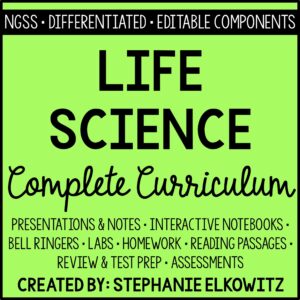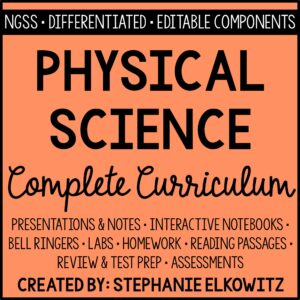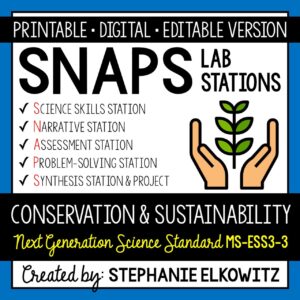Middle School Life Science NGSS Lessons and Labs
$314.25
Save 50% with a bundle of lessons and labs that support all middle school life science NGSS.
Includes:
• 59 Lessons (printable, digital and editable components)
• 35 Labs (printable, digital and fully editable)
Description
• This resource includes NGSS Aligned lessons and SNAPs labs for Middle School Life Science
• This bundle includes the MOST ESSENTIAL lessons and labs to align your classroom to NGSS
• Some activities are not aligned to NGSS but are included for completeness (*)
• The activities work in classrooms that complete printable activities with paper and pen
• All activities are available in digital format to support online-digital learning
Important Notes
• Download a FREE Lesson to learn more about the resources included in a single lesson
• Download a FREE SNAPs Lab Stations Activity to learn more about my SNAPs labs
• Consider my Integrated Science Complete Curriculum for teaching materials that span multiple grades
DISTANCE LEARNING – DIGITAL ASSIGNMENTS
This bundle includes modified files that facilitate online – distance learning:
• Fillable slides designed to work with Google Slides and Microsoft PowerPoint.
• Digital Assessments designed with Google Forms. Google Classrooms are not required.
• Digital Laboratory Activities with fully editable versions.
Important Notes about Fillable Slides:
• Bell Ringers, Homework, Reading Passages & Digital INBs are available as fillable slides.
• Digital assignments made as PPTX files work seamlessly with Google Slides: WATCH ME
• Digital assignments CANNOT be edited. Only the text boxes or forms can be manipulated.
• Each assignment is saved as an individual file with the answer key removed for easy distribution.
All Digital resources can be shared via platforms that are password-protected or accessible only to students.
The following lessons are included in this bundle:
From Molecules to Organisms
• Cell Theory*
• Unicellular vs. Multicellular (MS-LS1-1)
• Prokaryotes vs. Eukaryotes (MS-LS1-1)
• Animal Cells (MS-LS1-2)
• Plant Cells (MS-LS1-2)
• Animal vs. Plant Cells*
• Cell Membrane (MS-LS1-2)
• Cell Receptors and Communication (MS-LS1-2)
• Cell Transport (MS-LS1-2)
• Osmosis (MS-LS1-2)
• Endocytosis vs. Exocytosis (MS-LS1-2)
• Levels of Organization (MS-LS1-3)
• Human Body Systems*
• Major Organs*
• Organ System Interactions (MS-LS1-3)
• Locomotion (MS-LS1-3)
• [Animal] Life Cycle Adaptations (MS-LS1-4)
• Angiosperm Reproduction (MS-LS1-4)
• Leaf Adaptations (MS-LS1-4)
• Stem Adaptations (MS-LS1-4)
• Nature vs. Nurture (MS-LS1-5)
• The Environment and Gene Expression (MS-LS1-5)
• Environmental Influence on Plants (MS-LS1-5)
• Photosynthesis (MS-LS1-6)
• Fueling the Body (MS-LS1-7)
• Responding to Sensory Information (MS-LS1-8)
Ecosystems
• Carrying Capacity (MS-LS2-1)
• Ecological Relationships (MS-LS2-2)
• Symbiotic Relationships (MS-LS2-2)
• Types of Organisms*
• Types of Consumers*
• Food Chains & Webs (MS-LS2-3)
• Energy Flow through a Food Chain (MS-LS2-3)
• Energy Pyramid (MS-LS2-3)
• Carbon Cycle (MS-LS2-3)
• Oxygen and Carbon Dioxide Cycling (MS-LS2-3)
• Ecological Succession (MS-LS2-4)
• Changes in the Environment (Selective Pressure) (MS-LS2-4)
• Endangerment and Extinction (MS-LS2-4)
• Biodiversity (MS-LS2-5)
• Why is biodiversity important? (MS-LS2-5)
Heredity
• Mutations (MS-LS3-1)
• Genetic Diseases (MS-LS3-1)
• Mendelian Genetics (Mendel’s Experiments and Laws)*
• Dominant and Recessive Alleles*
• Punnett Squares (MS-LS3-2)
• Pedigrees (MS-LS3-2)
• Asexual Reproduction (MS-LS3-2)
• Sexual Reproduction (MS-LS3-2)
Biological Evolution
• Fossil Record (MS-LS4-1)
• Evidence for Evolution (MS-LS4-2)
• Comparative Anatomy (MS-LS4-2)
• Comparative Embryology (MS-LS4-3)
• Variation and Species Diversity (MS-LS4-4)
• Frequency of Traits (MS-LS4-6)
• Competition for Resources*
• Theory of Natural Selection (MS-LS4-6)
• Artificial Selection (MS-LS4-5)
• Genetic Technologies (MS-LS4-5)
The following labs are included in this bundle:
From Molecules to Organisms
• Unicellular vs. Multicellular Organisms Lab (MS-LS1-1)
• Prokaryotes vs. Eukaryotes Lab (MS-LS1-1)
• Animal and Plant Cells Lab (MS-LS1-2)
• Cell Receptors & Cell Communication Lab (MS-LS1-2)
• Cell Transport Lab (MS-LS1-2)
• Levels of Organization Lab (MS-LS1-3)
• Human Body Systems Interactions Lab (MS-LS1-3)
• Life Cycle Adaptations Lab (MS-LS1-4)
• Flowering Plant Life Cycle Lab (MS-LS1-4)
• Plant Adaptations Lab (MS-LS1-4)
• Environmental Influence on Plant Growth Lab (MS-LS1-5)
• Environmental Influence on Traits Lab (MS-LS1-5)
• Photosynthesis Lab (MS-LS1-6)
• Cellular Respiration Lab (MS-LS1-7)
• Responding to Sensory Information & Learning Lab (MS-LS1-8)
Ecosystems
• Carrying Capacity Lab (MS-LS2-1)
• Ecological Relationships Lab (MS-LS2-2)
• Plant Symbiosis Lab (MS-LS2-2)
• Carbon Cycle Lab (MS-LS2-3)
• Food Chains and Webs Lab (MS-LS2-3)
• Energy Pyramids Lab (MS-LS2-3)
• Ecological Succession Lab (MS-LS2-4)
• Endangerment and Extinction Lab (MS-LS2-4)
• Biodiversity Lab (MS-LS2-5)
Heredity
• Mutations Lab (MS-LS3-1)
• Punnett Squares Lab (MS-LS3-2)
• Pedigrees Lab (MS-LS3-2)
• Asexual vs. Sexual Reproduction Lab (MS-LS3-2)
Biological Evolution
• Fossil Record Lab (MS-LS4-1)
• Comparative Anatomy Lab (MS-LS4-2)
• Comparative Embryology Lab (MS-LS4-3)
• Variation and Genetic Diversity Lab (MS-LS4-4)
• Artificial Selection Lab (MS-LS4-5)
• Genetic Engineering Lab (MS-LS4-5)
• Natural Selection Lab (MS-LS4-6)
Lessons and Labs are organized by Disciplinary Core Ideas (DCI).
Each lesson includes:
• A Bell Ringer or Exit Slip tiered to Bloom’s Taxonomy (key included)
• EDITABLE PowerPoint Slides, Scaffolded Notes and Modified Notes
• One Page of INB Input Notes and an INB Activity (key included)
• A 4-5 Question Quiz (key included)
• A Two-Part Reflection Exercise
• A Homework Assignment (key included)
• A Reading Passage with Text-Dependent Comprehension Questions (key included)
• Digital Versions of all Activities for Electronic Distribution and Collection
POWERPOINT & NOTES
Each lesson includes PowerPoint slides, scaffolded notes and modified notes. These resources are 100% EDITABLE in Microsoft PowerPoint and Microsoft Word.
INB LESSON
Each lesson includes one INB lesson. The INB lesson consists of an overview with a photo of the completed INB activity, one page of input notes (differentiated when necessary), at least one INB activity, a 4-5 question mini assessment and a two-part reflection exercise. Each lesson includes a digital INB lesson with EDITABLE notes, a digital INB activity, digital reflection exercise and Google Form quiz. Key included.
BELL RINGER
Each lesson includes one tiered 3-part activity designed to “warmup” students at the beginning of a lesson. It can also be used as an exit slip at the end of a lesson. Full and half page printing options and key included. Fillable slide that can be used with Google classrooms and Microsoft Teams included.
HOMEWORK ASSIGNMENT
Each lesson includes one tiered 3-part homework assignment that probes low, mid and high order thinking. The assignment is designed to be completed in 15-20 minutes and can be used as a formative or summative assessment. Key included. Fillable slide that can be used with Google classrooms and Microsoft Teams included.
READING PASSAGE
Each lesson includes a one-page reading passage with text-dependent reading comprehension questions that probe low, mid and high order thinking. Key included. Fillable slide that can be used with Google classrooms and Microsoft Teams included. Immersive Reader compatible passage included.
IMMERSIVE READER
This resource includes a version of the reading passage that can be read to a student with Microsoft’s Immersive Reader. The Immersive-Reader compatible passage is a read-only word document accessed in a web browser. Internet access required. Students are provided a link to the Immersive Reader compatible passage in the printable and digital versions of the passage.
Immersive reader is a FREE Microsoft educational tool. You do NOT need a Microsoft account to access this tool in a web browser. Learn more about Immersive Reader HERE.
Immersive Reader can:
• Read the entire passage to a student
• Help pronounce individual words in a passage as a student reads
• Translate the entire passage or individual words in the passage for ESL students
• Change the font, text color and background color for students with visual impairments
Additional Notes
• Written and video instructions for students are included: http://safesha.re/ppk
• Download a FREE unit of Immersive Reader compatible reading passages HERE.
About SNAPs Lab Stations Activities
SNAPs Lab Stations require students to use science, math, literacy, problem-solving and engineering skills. They are designed to enhance students’ understanding of scientific concepts and help students apply scientific ideas. Each station activity promotes skills so to develop students into proficient and competent scientific thinkers.
SNAPs lab activities have five components:
• Science Skills Station to develop science skill proficiency
• Narrative Station to build science literacy
• Assessment Station to evaluate learning and understanding
• Problem-Solving Station to foster engineering design
• Synthesis Station and Project to inspire higher-order learning
DIGITAL LABORATORIES – DISTANCE LEARNING & DIGITAL CLASSROOMS
• The labs are offered in a digital format to support digital classrooms & distance learning.
• Each digital lab activity is designed to work with Google Slides and Microsoft PowerPoint
• Each digital lab activity CANNOT be edited. However:
– Students can manipulate text boxes
– Students can create tables, graphs and diagrams
– Students can insert images and drawings
GOOGLE FORM ASSESSMENT STATION
• Each assessment station is offered as a self-grading Google Form.
• Questions are all short answer and are 100% editable.
• Suggestions for use are included in the download.
DISTANCE LEARNING COMPATIBILITY
SNAPs lab activities are rated for their ease with distance – independent learning. Refer to the preview for each individual lab for more information about how well each laboratory works in a fully digital classroom and with distance learning.
EDITABLE DOCUMENTS
This download includes an editable word document (docx file) of all lab components:
• Pre-Lab and Post-Lab Activities
• The Lab Overview
• Lab Station Activities and Questions
• Directed Synthesis Project (when applicable)
Important Notes:
• Diagrams, illustrations, tables and graphs essential to lab activities are included
• Illustrative clipart is NOT included
• Editable documents and rubrics are included with the FREE SNAPs Setup Guide
Editable files allow you to:
• Edit the scope of the activities so to suit your students’ needs
• Edit the materials required based on resource availability
• Create single-period “mini-labs” using activities at the individual skills stations
SHARING FILES for Distance Learning, Homeschooling or At-Home Tutoring
Teachers can share all files in this download with students via email, password-protected websites (ex. Google Classrooms or Microsoft Teams) or secure file sharing platforms (ex. Google Drive, OneDrive or DropBox). You CAN share this digital resource with your students as long as the general public cannot access the files.
TERMS OF USE
• All rights reserved by Stephanie Elkowitz.
• This product is to be used by the original purchaser only.
• Intended for classroom and personal use only.
• Copying for more than one teacher, classroom, department, school, or school system is prohibited.
• This product may not be distributed or displayed digitally for public view.
• Failure to comply is a copyright infringement and a violation of the Digital Millennium Copyright Act (DMCA).








